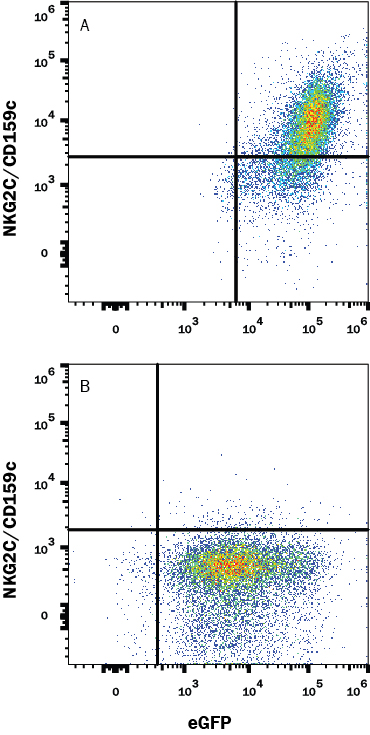Mouse NKG2C/CD159c Antibody Summary
Accession # NP_034783
Applications
Please Note: Optimal dilutions should be determined by each laboratory for each application. General Protocols are available in the Technical Information section on our website.
Scientific Data
 View Larger
View Larger
Detection of NKG2C/CD159c in HEK293 Human Cell Line Transfected with Mouse NKG2C/CD159c and eGFP by Flow Cytometry. HEK293 human embryonic kidney cell line transfected with either (A) mouse NKG2C/CD159c or (B) mouse NKG2A/CD159a and eGFP was stained with Rabbit Anti-Mouse NKG2c/CD159c Monoclonal Antibody (Catalog # MAB1382) followed by APC-conjugated Anti-Rabbit IgG Secondary Antibody (Catalog # F0111). Quadrant markers were set based on control antibody staining (Catalog # MAB1050). View our protocol for Staining Membrane-associated Proteins.
Reconstitution Calculator
Preparation and Storage
- 12 months from date of receipt, -20 to -70 °C as supplied.
- 1 month, 2 to 8 °C under sterile conditions after reconstitution.
- 6 months, -20 to -70 °C under sterile conditions after reconstitution.
Background: NKG2C/CD159c
NKG2C (NK cell Group 2 isoform C; Killer cell lectin-like receptor subfamily C, member 2) is a member of the C-type lectin-like superfamily of proteins. Natural killer (NK) receptors are expressed in both NK cells and cytotoxic CD8+ T cells and have both activating and inhibitory members (1-3). Regulation of the balance between the activating and inhibitory receptors is important and lack of such regulation has been implicated in autoimmunity (4). The NKG2 family includes seven receptors: NKG2A, -B, -C, -D, -E, -F, and -H, which is the longer isoform of NKG2E. Except for NKG2D and NKG2F, the NKG2 family members form heterodimers with CD94 (5, 6). NKG2C interacts with the adapter molecule DAP12 and acts as activating receptor when heterodimerized with CD94 (7). Human NKG2C is synthesized as a 231 amino acid (aa) protein that includes a 70 aa cytoplasmic domain, a 23 aa transmembrane segment, and a 138 aa extracellular domain (ECD). Within the ECD, human NKG2C shares 40% sequence identity with mouse NKG2C. NKG2C-CD94 heterodimers bind to the widely expressed nonclassical MHC-I molecule, HLA-E (Qa-1b in mouse), which presents a peptide derived from the signal peptide of classical MHC-I molecules (8, 9). Triggering the NKG2C-CD94 complex may activate the cytolytic activity and cytokine production of NK and CD8+ T cells (8, 10). Human cytomegalovirus (HCMV) infection promotes the differentiation and expansion of NKG2C+ NK cell subsets, possibly involving a cognate interaction of CD94/NKG2C with ligand(s) displayed by HCMV‑infected cells (11, 12).
- Orbelyan, G.A. et al. (2014) J. Immunol. 193:610.
- Tassi I. et al. (2006) Immnunol Rev. 214:92.
- Lanier, L.L. (2008) Nat. Immunol. 9:495.
- Schleinitz, N. et al. (2010) Immunology. 174:2878.
- Lopez-Botet, M. et al. (2000) Hum. Immunol. 61:7.
- Braud, V.M. et al. (1998) Nature. 391:795.
- Lanier, L.L. (1998) Immunity 8:693.
- Vance, R.E. et al. (1999) J Exp Med 190:1801.
- Kaiser B.K. et al. (2005) J Immunol 174:2878.
- Bellón T. et al. (1999) J Immunol 162:3996.
- Pupuleku A. et al. (2017) Front Immunol. 8:1317.
- Hammer Q. et al. (2018) Nat Immunol. 19:453.
Product Datasheets
FAQs
No product specific FAQs exist for this product, however you may
View all Antibody FAQsReviews for Mouse NKG2C/CD159c Antibody
There are currently no reviews for this product. Be the first to review Mouse NKG2C/CD159c Antibody and earn rewards!
Have you used Mouse NKG2C/CD159c Antibody?
Submit a review and receive an Amazon gift card.
$25/€18/£15/$25CAN/¥75 Yuan/¥2500 Yen for a review with an image
$10/€7/£6/$10 CAD/¥70 Yuan/¥1110 Yen for a review without an image


